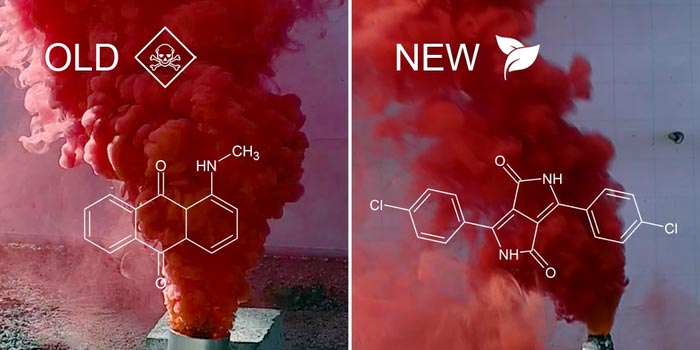A ‘greener’ alternative for red-colored smoke

Dyes currently used for red smoke (left), such as that found in flares, could be toxic, so researchers identified a safer alternative (right).
Credit: Adapted from ACS Sustainable Chemistry & Engineering 2022, DOI: 10.1021/acssuschemeng.2c01000
The red smoke of a flare on a roadway warns motorists to be cautious, but the anthraquinone dyes currently used to produce this smoke are thought to be harmful to human health. Now, researchers reporting in ACS Sustainable Chemistry & Engineering have identified a less toxic, “greener” alternative — an organic dye called pigment red 254 (PR254). It also forms a red-colored smoke cloud more effectively than current dyes, the researchers say.
Commercialized in 1986, diketopyrrolopyrrole (DPP) dyes are used as colorants in car paints (such as the famous “Ferrari red”), optics technologies and other applications. For the purpose of signal smokes, Vojtech Pelikan and colleagues chose the DPP dye PR254, which has a brilliant red color and is less toxic than anthraquinone dyes. In experiments, the researchers showed that a PR254-containing pyrotechnic composition reached a yield of red-colored smoke of 51%, compared with only 48% for the usual anthraquinone dye. PR254 was also more thermally stable than the reference dye, which might allow it to be used in a less toxic heat-generating system, according to the researchers.
The authors acknowledge funding from the University of Pardubice.
The American Chemical Society (ACS) is a nonprofit organization chartered by the U.S. Congress. ACS’ mission is to advance the broader chemistry enterprise and its practitioners for the benefit of Earth and all its people. The Society is a global leader in promoting excellence in science education and providing access to chemistry-related information and research through its multiple research solutions, peer-reviewed journals, scientific conferences, eBooks and weekly news periodical Chemical & Engineering News. ACS journals are among the most cited, most trusted and most read within the scientific literature; however, ACS itself does not conduct chemical research. As a leader in scientific information solutions, its CAS division partners with global innovators to accelerate breakthroughs by curating, connecting and analyzing the world’s scientific knowledge. ACS’ main offices are in Washington, D.C., and Columbus, Ohio.
To automatically receive news releases from the American Chemical Society, contact newsroom@acs.org.
Journal: ACS Sustainable Chemistry & Engineering
DOI: 10.1021/acssuschemeng.2c01000
Article Title: Diketopyrrolopyrrole — A Greener Alternative for Pyrotechnic Smoke Compositions”
Article Publication Date: 30-Mar-2022
Media Contact
Katie Cottingham
American Chemical Society
k_cottingham@acs.org
Office: 301-775-8455
All latest news from the category: Life Sciences and Chemistry
Articles and reports from the Life Sciences and chemistry area deal with applied and basic research into modern biology, chemistry and human medicine.
Valuable information can be found on a range of life sciences fields including bacteriology, biochemistry, bionics, bioinformatics, biophysics, biotechnology, genetics, geobotany, human biology, marine biology, microbiology, molecular biology, cellular biology, zoology, bioinorganic chemistry, microchemistry and environmental chemistry.
Newest articles

NASA: Mystery of life’s handedness deepens
The mystery of why life uses molecules with specific orientations has deepened with a NASA-funded discovery that RNA — a key molecule thought to have potentially held the instructions for…

What are the effects of historic lithium mining on water quality?
Study reveals low levels of common contaminants but high levels of other elements in waters associated with an abandoned lithium mine. Lithium ore and mining waste from a historic lithium…

Quantum-inspired design boosts efficiency of heat-to-electricity conversion
Rice engineers take unconventional route to improving thermophotovoltaic systems. Researchers at Rice University have found a new way to improve a key element of thermophotovoltaic (TPV) systems, which convert heat…



